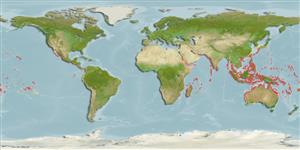Common names from other countries
Environment: milieu / climate zone / depth range / distribution range
экология
; пределы глубины 2 - 5 m (Ref. 101327). Tropical
Indo-Pacific: from East Africa to eastern Polynesia, not in the Red Sea, the Persian Gulf, nor the Gulf of Bengal; north to Japan and Hawaii, and south to central Queensland and New Caledonia.
Length at first maturity / Size / Вес / Возраст
Maturity: Lm ? range ? - ? cm Max length : 13.0 cm SHL самец/пол неопределен; (Ref. 349); common length : 10.0 cm SHL самец/пол неопределен; (Ref. 349)
Frequently in the Indo-West Pacific for food and shellcraft (Ref. 349). Depth range is based on occurrence in French Polynesia (Ref. 101327); to be replaced with a better reference. Under stones and in crevices of rocky headlands exposed to strong wave action (Ref. 349). Usually found among dark rocks (Ref. 799). Mostly active at night. Mainly inhabits shallow subtidal levels. Occurs at the low tide mark (Ref. 349). Most cypraeids are herbivores (Ref. 113307).
Life cycle and mating behavior
половая зрелость | размножение | нерест | икра | Fecundity | личинки
Members of the order Neotaenioglossa are mostly gonochoric and broadcast spawners. Life cycle: Embryos develop into planktonic trocophore larvae and later into juvenile veligers before becoming fully grown adults.
Основная ссылка
ссылки | координатор | соавторы
Poutiers, J.M. 1998. (Ref. 349)
Статус Красного Списка МСОП (Ref. 130435)
Статус СИТЕС (Ref. 108899)
Not Evaluated
Not Evaluated
Угроза для людей
Harmless
Использование человеком
рыболовство: коммерческий
| FishSource | Sea Around Us
инструменты
дополнительная информация
Возраст/РазмерыростЗависимость между длиной и массой телаЗависимость между длинамиморфологияличинкичисленность
ресурсы в Интернет
Estimates based on models
Preferred temperature
(Ref.
115969): 24.7 - 29.3, mean 28.4 (based on 3363 cells).
Уязвимость
Low vulnerability (10 of 100).
Категория цены
Unknown.
